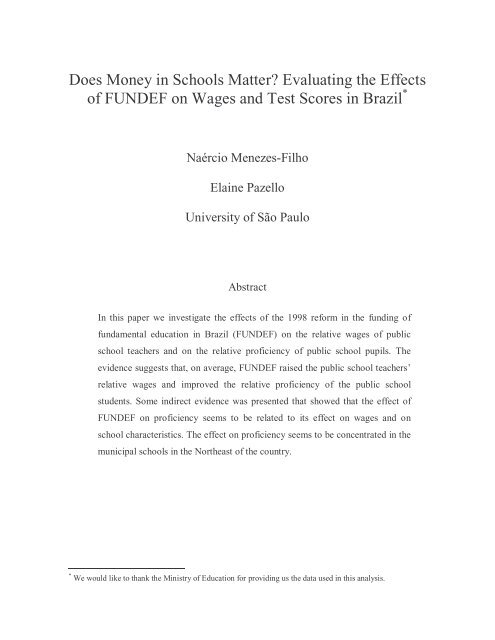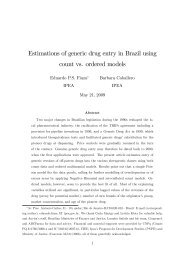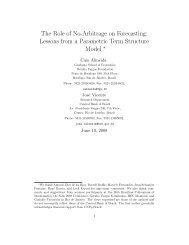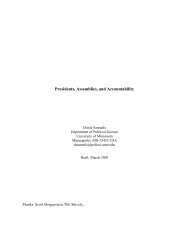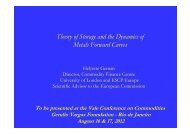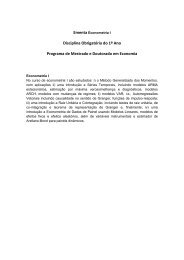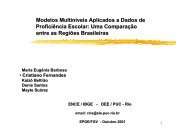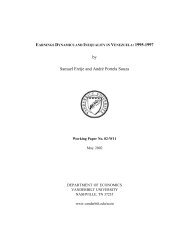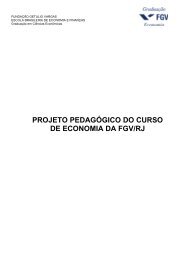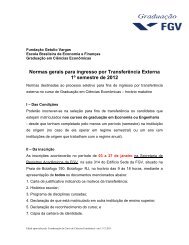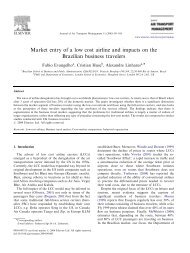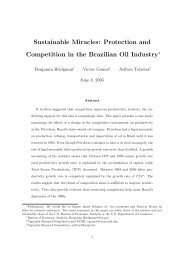Does Money in Schools Matter? Evaluating the Effects ... - EPGE/FGV
Does Money in Schools Matter? Evaluating the Effects ... - EPGE/FGV
Does Money in Schools Matter? Evaluating the Effects ... - EPGE/FGV
You also want an ePaper? Increase the reach of your titles
YUMPU automatically turns print PDFs into web optimized ePapers that Google loves.
<strong>Does</strong> <strong>Money</strong> <strong>in</strong> <strong>Schools</strong> <strong>Matter</strong> Evaluat<strong>in</strong>g <strong>the</strong> <strong>Effects</strong><br />
of FUNDEF on Wages and Test Scores <strong>in</strong> Brazil *<br />
Naércio Menezes-Filho<br />
Ela<strong>in</strong>e Pazello<br />
University of São Paulo<br />
Abstract<br />
In this paper we <strong>in</strong>vestigate <strong>the</strong> effects of <strong>the</strong> 1998 reform <strong>in</strong> <strong>the</strong> fund<strong>in</strong>g of<br />
fundamental education <strong>in</strong> Brazil (FUNDEF) on <strong>the</strong> relative wages of public<br />
school teachers and on <strong>the</strong> relative proficiency of public school pupils. The<br />
evidence suggests that, on average, FUNDEF raised <strong>the</strong> public school teachers’<br />
relative wages and improved <strong>the</strong> relative proficiency of <strong>the</strong> public school<br />
students. Some <strong>in</strong>direct evidence was presented that showed that <strong>the</strong> effect of<br />
FUNDEF on proficiency seems to be related to its effect on wages and on<br />
school characteristics. The effect on proficiency seems to be concentrated <strong>in</strong> <strong>the</strong><br />
municipal schools <strong>in</strong> <strong>the</strong> Nor<strong>the</strong>ast of <strong>the</strong> country.<br />
* We would like to thank <strong>the</strong> M<strong>in</strong>istry of Education for provid<strong>in</strong>g us <strong>the</strong> data used <strong>in</strong> this analysis.
1) Introduction<br />
In terms of <strong>in</strong>come distribution, Brazil is one <strong>the</strong> most unequal countries <strong>in</strong> <strong>the</strong> world. 1<br />
Education plays an import role <strong>in</strong> expla<strong>in</strong><strong>in</strong>g this fact, as about 50% of <strong>the</strong> <strong>in</strong>come<br />
distribution <strong>in</strong> Brazil can be associated with education. This happens because returns to<br />
education are very high <strong>in</strong> Brazil and only a small proportion of <strong>the</strong> population has access<br />
to higher levels of education. 2 Despite <strong>the</strong> fact that access to <strong>the</strong> first school<strong>in</strong>g year is<br />
almost universal <strong>in</strong> Brazil, children from a poor background tend to drop out of <strong>the</strong> school<br />
system quite early on. 3<br />
One <strong>the</strong> reasons beh<strong>in</strong>d this high drop-out rate may be <strong>the</strong> quality<br />
of <strong>the</strong> education <strong>the</strong>y receive <strong>in</strong> <strong>the</strong> public system.<br />
In 1998, a reform <strong>in</strong> <strong>the</strong> fund<strong>in</strong>g of <strong>the</strong> public fundamental education system was<br />
<strong>in</strong>troduced <strong>in</strong> Brazil, with <strong>the</strong> creation of FUNDEF (Fundo para Manutenção e<br />
Desenvolvimento do Ens<strong>in</strong>o Fundamental e Valorização do Magistério – Fund for<br />
Ma<strong>in</strong>tenance and Development of <strong>the</strong> Fundamental Education and Valorization of<br />
Teach<strong>in</strong>g). FUNDEF ma<strong>in</strong> aim is redistribute resources from <strong>the</strong> richer to <strong>the</strong> poorer<br />
regions and to <strong>in</strong>crease public teachers´ wages. The aim of this paper is to exam<strong>in</strong>e whe<strong>the</strong>r<br />
<strong>the</strong> <strong>in</strong>troduction of FUNDEF has <strong>in</strong> fact <strong>in</strong>creased <strong>the</strong> earn<strong>in</strong>gs of <strong>the</strong> public school<br />
teachers, relative to <strong>the</strong>ir private schools counterparts, and <strong>the</strong> relative performance of<br />
public school pupils <strong>in</strong> test scores.<br />
The Brazilian education system is divided <strong>in</strong> cycles. The first cycle (primary<br />
education) consists of four years, <strong>the</strong> second (secondary) also has four years, <strong>the</strong> third (high<br />
1 The 10% <strong>in</strong> <strong>the</strong> top of <strong>the</strong> <strong>in</strong>come distribution appropriate 50% of all <strong>in</strong>come <strong>in</strong> Brazil.<br />
2 See Menezes-Filho et al (2002). A college graduate earns about three times more than a high school<br />
graduate and only about 10% of <strong>the</strong> population has a college degree.<br />
3 See Filmer, D and Prichett, L. (1998)
school) lasts three years and <strong>the</strong> fourth (college) usually lasts between four and five years.<br />
The primary and secondary cycles toge<strong>the</strong>r form what is called <strong>the</strong> fundamental education,<br />
which was affected by <strong>the</strong> <strong>in</strong>troduction of FUNDEF.<br />
The system has both private (paid) and public (free) schools. Figure 1 presents <strong>the</strong><br />
share of pupils study<strong>in</strong>g <strong>in</strong> private schools and <strong>the</strong> share of schools that are privately owned<br />
<strong>in</strong> selected grades. One can notice that <strong>the</strong> share of students <strong>in</strong> private schools rises with <strong>the</strong><br />
level of education, which can be expla<strong>in</strong>ed by <strong>the</strong> high drop-out rate among kids from a<br />
poor background, which tend to study <strong>in</strong> public schools. Moreover, <strong>the</strong> share of private<br />
schools is higher than <strong>the</strong> share of students <strong>in</strong> private schools, especially from <strong>the</strong> 8 th grade<br />
onwards, which means that private schools tend to have fewer students than <strong>the</strong> public ones<br />
after that grade.<br />
In terms of college education, <strong>the</strong> situation is radically different, s<strong>in</strong>ce students from<br />
public colleges perform much better on average <strong>in</strong> evaluation tests than do <strong>the</strong> students<br />
from private <strong>in</strong>stitutions. As such, <strong>the</strong>re is a very competitive exam to ga<strong>in</strong> admission <strong>in</strong>to<br />
each of <strong>the</strong> public colleges, and students from private high schools generally do much<br />
better <strong>in</strong> <strong>the</strong>se admissions exams than do pupils from <strong>the</strong> public school system that<br />
managed to conclude high school. Therefore, most of <strong>the</strong> students from a poor background,<br />
which went through <strong>the</strong> public high school system, have to go to private colleges or try<br />
<strong>the</strong>ir luck <strong>in</strong> <strong>the</strong> labor market and <strong>in</strong>equality tends to self-perpetuate.<br />
For all <strong>the</strong>se reasons, it is important to evaluate an education reform that aimed at<br />
chang<strong>in</strong>g <strong>the</strong> fund<strong>in</strong>g structure of <strong>the</strong> public school system, <strong>in</strong> order to redistribute<br />
resources to <strong>the</strong> poorest regions, such as FUNDEF. Barros et al (2001), us<strong>in</strong>g household<br />
level data, found that <strong>the</strong> wages of public school teachers rose by about 8% with respect to<br />
those <strong>in</strong> <strong>the</strong> private sector <strong>in</strong> <strong>the</strong> sou<strong>the</strong>ast of Brazil. Anuatti Neto et al (2003) also found
that <strong>the</strong> relative wages of public school teachers <strong>in</strong>creased between 1997 and 1999,<br />
particularly <strong>in</strong> <strong>the</strong> municipal system <strong>in</strong> <strong>the</strong> Nor<strong>the</strong>ast of Brazil, which <strong>the</strong>y attribute to<br />
FUNDEF. However, <strong>the</strong>re is no study evaluat<strong>in</strong>g <strong>the</strong> impact of FUNDEF us<strong>in</strong>g school level<br />
data and exam<strong>in</strong><strong>in</strong>g its effects on <strong>the</strong> relative proficiency of public school pupils. We th<strong>in</strong>k<br />
that this paper also relates to a broader literature <strong>the</strong> tries to evaluate <strong>the</strong> impact of<br />
resources spent on education and on teacher labor market (see Hanushek, 2003, for<br />
example).<br />
The structure of <strong>the</strong> paper is as follows. In section 2 we describe <strong>the</strong> FUNDEF<br />
program and section 3 describes <strong>the</strong> data. Section 4 presents <strong>the</strong> econometric methodology,<br />
while <strong>the</strong> results are presented <strong>in</strong> section 5 and <strong>the</strong> conclusions <strong>in</strong> section 6.<br />
2) The FUNDEF Program<br />
In each Brazilian municipality, <strong>the</strong> public schools may belong to <strong>the</strong> State system or to <strong>the</strong><br />
municipality system. The new Brazilian constitution, which took effect <strong>in</strong> 1988, stated that<br />
all States, Municipalities and <strong>the</strong> Federal Government had to spend a fixed share of <strong>the</strong>ir<br />
tax and transfer revenues <strong>in</strong> <strong>the</strong>ir public education system. This share was equal to 25% <strong>in</strong><br />
<strong>the</strong> cases of states and municipalities and 18% <strong>in</strong> <strong>the</strong> case of <strong>the</strong> federal government. With<br />
this new legislation, <strong>the</strong> amount of resources allocated to education <strong>in</strong>creased, but <strong>the</strong> so did<br />
heterogeneity of <strong>the</strong> public schools, s<strong>in</strong>ce richer states with a small share of students <strong>in</strong> <strong>the</strong>ir<br />
system were spend<strong>in</strong>g much more per pupil than were poor municipalities with a large<br />
share of students. Moreover, <strong>the</strong>re was no mechanism to enforce that <strong>the</strong> education
esources were effectively be<strong>in</strong>g spent on <strong>the</strong> educational system itself and not on o<strong>the</strong>r<br />
activities that could be remotely l<strong>in</strong>ked to education. 4<br />
The <strong>in</strong>troduction of FUNDEF aimed at chang<strong>in</strong>g <strong>the</strong> structure of fund<strong>in</strong>g <strong>in</strong><br />
fundamental education. S<strong>in</strong>ce its implementation (January 1 st 1998) and for a period of 10<br />
years, all municipalities and states had to spend 60% of <strong>the</strong>ir education resources (that is,<br />
15% of <strong>the</strong>ir revenues) exclusively with <strong>the</strong> ma<strong>in</strong>tenance and development of its<br />
fundamental education. However, <strong>in</strong>stead of be<strong>in</strong>g directly applied by <strong>the</strong> government unit,<br />
all resources were firstly directed to a common fund. In a second moment, <strong>the</strong> resources<br />
were redistributed to <strong>the</strong> states and municipalities, <strong>in</strong> direct proportion to <strong>the</strong> number of<br />
students enrolled <strong>in</strong> each state and municipality fundamental school system. Moreover,<br />
60% of <strong>the</strong> resources received through this fund had to be spent with teachers´ wages.<br />
F<strong>in</strong>ally, a m<strong>in</strong>imum amount of spend<strong>in</strong>g per pupil was established, and <strong>in</strong> <strong>the</strong> cases where<br />
this amount could not be achieved with <strong>the</strong> fund resources alone, <strong>the</strong> federal government<br />
would complement it.<br />
Hence, FUNDEF affected <strong>the</strong> education system <strong>in</strong> several ways. Suppose that a<br />
municipality had revenues (from tax and transfers) that amounted to R$100. With <strong>the</strong> 1988<br />
constitution, it had to dest<strong>in</strong>e R$25 to education <strong>in</strong> any way it preferred. After FUNDEF, it<br />
had to donate R$15 to <strong>the</strong> fund, whereas <strong>the</strong> amount if received back depended on <strong>the</strong><br />
number of pupils enrolled <strong>in</strong> <strong>the</strong> fundamental education. If its share of pupils was equal to<br />
its share of resources to <strong>the</strong> fund, it would receive <strong>the</strong> same R$15 back. Moreover, at least<br />
R$9 had to be spent <strong>in</strong> teachers´ wages.<br />
4 Rich municipalities with a small number of public schools, for example, spent <strong>the</strong> resources <strong>in</strong><br />
activities remotely related to <strong>the</strong> education, like street pavements near <strong>the</strong> school, sports gymnasium, etc..
Therefore, <strong>the</strong> impact of FUNDEF on <strong>the</strong> schools and on teachers’ wages <strong>in</strong> a<br />
municipality or state depended on <strong>the</strong> amount of resources <strong>in</strong>itially allocated to <strong>the</strong><br />
fundamental education system out of its education budget; on <strong>the</strong> <strong>in</strong>itial share of wages out<br />
of this amount and on its share of enrollments as compared to its share of revenues with<strong>in</strong><br />
<strong>the</strong> State.<br />
Table 1 reports <strong>the</strong> f<strong>in</strong>ancial redistribution that took place between <strong>the</strong> each state<br />
and its municipalities <strong>in</strong> 1998 for <strong>the</strong> different regions. The transfers with<strong>in</strong> a State would<br />
sum zero, were it not for <strong>the</strong> federal government transfers that complement <strong>the</strong> budget if <strong>the</strong><br />
expenditures per student do not reach <strong>the</strong> m<strong>in</strong>imum amount. It is clear that <strong>in</strong> all regions,<br />
with <strong>the</strong> exception of <strong>the</strong> south-east (SE), <strong>the</strong> transfer favored <strong>the</strong> municipalities. This<br />
happened because <strong>the</strong>ir proportion of enrolments was high relative to <strong>the</strong> proportion of <strong>the</strong>ir<br />
revenues.<br />
Figure 2 shows <strong>the</strong> behavior <strong>the</strong> expenditures on education <strong>in</strong> each state as a<br />
proportion of <strong>the</strong> GDP over time. S<strong>in</strong>ce <strong>the</strong> proportion of <strong>the</strong> revenues spent on education<br />
<strong>in</strong> each unit should be constant over time (determ<strong>in</strong>ed by <strong>the</strong> Constitution), <strong>the</strong> changes <strong>in</strong><br />
<strong>the</strong> share of education expenditures should correspond to changes <strong>in</strong> <strong>the</strong> revenues/GDP<br />
ration. It is clear that <strong>the</strong>re was a rise <strong>in</strong> <strong>the</strong> share of education expenditures <strong>in</strong> <strong>the</strong> country<br />
as a whole between 1997 and 1998, with <strong>the</strong> ma<strong>in</strong> responsible be<strong>in</strong>g <strong>the</strong> states and<br />
municipalities of <strong>the</strong> Nor<strong>the</strong>ast, where <strong>the</strong> rise actually start<strong>in</strong>g <strong>in</strong> 1997. Therefore, a higher<br />
share of resources was be<strong>in</strong>g spent on education over <strong>the</strong> period under analysis.<br />
FUNDEF established that 60% of all education resources should be spent on<br />
fundamental education. Figure 3 shows that <strong>the</strong> states were, on average, already spend<strong>in</strong>g<br />
more than 60% of its education resources on fundamental education <strong>in</strong> 1997. This is also<br />
true for each state and municipal system separately, except for <strong>the</strong> state system <strong>in</strong> Sao
Paulo, Rio de Janeiro and Paraná (figure not shown). Between 1998 and 1999, one can<br />
notice a decl<strong>in</strong>e <strong>in</strong> share of resources accru<strong>in</strong>g to fundamental education and a rise <strong>in</strong> <strong>the</strong><br />
high school share of education expenditures.<br />
Figure 4 shows that <strong>the</strong> Municipal system as a whole was already spend<strong>in</strong>g about<br />
70% of its education resources on <strong>the</strong> fundamental cycle. The São Paulo municipalities<br />
were <strong>the</strong> only ones spend<strong>in</strong>g less than <strong>the</strong> m<strong>in</strong>imum required, on average (figure not<br />
shown). However, <strong>the</strong> share of resources spent on <strong>the</strong> fundamental education rose by about<br />
8% between 1997 and 1998, with a similar decl<strong>in</strong>e <strong>in</strong> <strong>the</strong> amount dest<strong>in</strong>ed to <strong>the</strong> pre-school<br />
system. This could be <strong>the</strong> result of <strong>the</strong> effort made by municipalities that were not<br />
previously spend<strong>in</strong>g <strong>the</strong> m<strong>in</strong>imum required and had to substitute resources away from <strong>the</strong><br />
pre-school to <strong>the</strong> fundamental education.<br />
Figure 5 presents <strong>the</strong> evolution of <strong>the</strong> total number of students <strong>in</strong> <strong>the</strong> fundamental<br />
education <strong>in</strong> each system (state, municipality and private schools) between 1997 and 1999.<br />
It is clear that <strong>the</strong> total number of students rose over time, with a rise <strong>in</strong> <strong>the</strong> number of<br />
students <strong>in</strong> <strong>the</strong> municipal system more than compensat<strong>in</strong>g for <strong>the</strong> decl<strong>in</strong>e <strong>in</strong> <strong>the</strong> number of<br />
students <strong>in</strong> <strong>the</strong> state system. It seems <strong>the</strong>refore that students are be<strong>in</strong>g transferred fron <strong>the</strong><br />
state to <strong>the</strong> municipal system, which could perhaps be associated with <strong>the</strong> shifts <strong>in</strong> <strong>the</strong><br />
allocation of <strong>the</strong> education resources from <strong>the</strong> states to <strong>the</strong> municipalities. It is <strong>in</strong>terest<strong>in</strong>g to<br />
note however, that <strong>the</strong>se movements to <strong>the</strong> municipal system and away from <strong>the</strong> State<br />
system occurred even <strong>in</strong> <strong>the</strong> states which experienced a shift <strong>in</strong> resources <strong>in</strong> <strong>the</strong> opposite<br />
direction, like São Paulo and M<strong>in</strong>as Gerais, which means that it could actually reflect a<br />
trend that pre-dates <strong>the</strong> <strong>in</strong>troduction of Fundef.<br />
In Figure 6 we present <strong>the</strong> evolution of <strong>the</strong> real expenditures per pupil <strong>in</strong> <strong>the</strong><br />
fundamental education <strong>in</strong> <strong>the</strong> state and municipal systems and <strong>in</strong> Brazil as a whole. It is
clear that <strong>the</strong>re was a rise <strong>in</strong> real expenditures between 1997 and 1998, <strong>in</strong> both <strong>the</strong> state and<br />
<strong>the</strong> municipal systems, despite <strong>the</strong> rise <strong>in</strong> <strong>the</strong> number of students, followed by a decl<strong>in</strong>e <strong>in</strong><br />
<strong>the</strong> level of expenditures <strong>in</strong> <strong>the</strong> state system between 1998 and 1999.<br />
Figures 7 and 8 present <strong>the</strong> equivalent numbers for <strong>the</strong> Nor<strong>the</strong>ast and Sou<strong>the</strong>ast<br />
regions separately. One can notice from figure 7 that <strong>in</strong> <strong>the</strong> nor<strong>the</strong>ast <strong>the</strong> pattern is very<br />
similar to <strong>the</strong> one observed for <strong>the</strong> country as a whole. The stabilization of real<br />
expenditures between 1998 and 1999 despite fall<strong>in</strong>g expenditures <strong>in</strong> both <strong>the</strong> municipal and<br />
state systems can be expla<strong>in</strong>ed by <strong>the</strong> rise <strong>in</strong> <strong>the</strong> federal transfer to <strong>the</strong> units that did not<br />
reach <strong>the</strong> stipulated m<strong>in</strong>imum amount of expenditures per pupil. Figure 8 shows that <strong>in</strong> <strong>the</strong><br />
Sou<strong>the</strong>ast region, where <strong>the</strong> state system was a net beneficiary of <strong>the</strong> FUNDEF program,<br />
real expenditures <strong>in</strong> <strong>the</strong> municipal system fell cont<strong>in</strong>uously between 1997 and 1999.<br />
Figure 9 shows that <strong>the</strong> number of schools offer<strong>in</strong>g fundamental education fell<br />
between 1997 and 1999 especially due to <strong>the</strong> fall <strong>in</strong> <strong>the</strong> number of State schools, although<br />
<strong>the</strong>re was a slight fall <strong>in</strong> <strong>the</strong> number of municipal schools as well. This happened both <strong>in</strong><br />
<strong>the</strong> Nor<strong>the</strong>ast ad <strong>in</strong> <strong>the</strong> Sou<strong>the</strong>ast (figures not shown), with <strong>the</strong> exception of <strong>the</strong> number of<br />
municipal schools <strong>in</strong> <strong>the</strong> sou<strong>the</strong>ast, which rose between 1997 and 1998, despite <strong>the</strong> fall <strong>in</strong><br />
real expenditures documented <strong>in</strong> <strong>the</strong> previous figure.<br />
Despite <strong>the</strong> fall <strong>in</strong> <strong>the</strong> number of schools, Figure 10 shows that <strong>the</strong> total number of<br />
teachers actually rose between 1997 and 1999, ma<strong>in</strong>ly due to <strong>the</strong> rise <strong>in</strong> <strong>the</strong> municipal<br />
system, which out-weighted <strong>the</strong> fall <strong>in</strong> <strong>the</strong> state system. It seems <strong>the</strong>refore that teachers also<br />
moved from <strong>the</strong> municipal to <strong>the</strong> state system, follow<strong>in</strong>g <strong>the</strong>ir students. This was true both<br />
<strong>in</strong> <strong>the</strong> Nor<strong>the</strong>ast and <strong>in</strong> <strong>the</strong> Sou<strong>the</strong>ast regions as well (figures not shown). It is important to<br />
note that <strong>the</strong> number of private schools and of <strong>the</strong>ir teachers has rema<strong>in</strong>ed constant over<br />
this time frame, s<strong>in</strong>ce <strong>the</strong>y will form our control group.
F<strong>in</strong>ally, Figure 11 shows that average class sizes rema<strong>in</strong>ed basically constant<br />
between 1997 and 1999 <strong>in</strong> <strong>the</strong> system as a whole, but <strong>the</strong>re was a rise <strong>in</strong> <strong>the</strong> average class<br />
size <strong>in</strong> <strong>the</strong> municipal system, which was compensated by a fall <strong>in</strong> <strong>the</strong> private schools. This<br />
was especially true <strong>in</strong> <strong>the</strong> Nor<strong>the</strong>ast (figures not shown).<br />
3) Econometric Methodology<br />
The empirical strategy we will follow to evaluate <strong>the</strong> impact of <strong>the</strong> FUNDEF program is<br />
based on <strong>the</strong> differences-<strong>in</strong>-differences methodology, used <strong>in</strong> Card (1990) and described <strong>in</strong><br />
details by Angrist and Krueger (1999). In <strong>the</strong> first step of his methodology we evaluate<br />
whe<strong>the</strong>r <strong>the</strong> FUNDEF impacted <strong>the</strong> public schools teachers’ wages relative to <strong>the</strong>ir private<br />
schools counterparts. In <strong>the</strong> second step we <strong>in</strong>vestigate whe<strong>the</strong>r FUNDEF has improved <strong>the</strong><br />
proficiency of <strong>the</strong> public schools pupils with respect to <strong>the</strong>ir private schools counterparts.<br />
FUNDEF was <strong>in</strong>troduced <strong>in</strong> 1998. Therefore, if FUNFED was effective <strong>in</strong> rais<strong>in</strong>g<br />
public schools teachers’ wages, one should observe an <strong>in</strong>crease <strong>in</strong> <strong>the</strong>ir relative wages <strong>in</strong><br />
1999 with respect to <strong>the</strong>ir relative wages <strong>in</strong> 1997. More formally, suppose that <strong>the</strong><br />
conditional mean wages are def<strong>in</strong>ed by:<br />
E[ ] = β + γ<br />
(1)<br />
w oi<br />
t<br />
s<br />
In <strong>the</strong> absence of FUNDEF, <strong>the</strong> teachers’ wages would be equal to <strong>the</strong> sum of a year effect<br />
that is common to all schools and a school effect (public or private) that is fixed over time. 5<br />
Suppose also that <strong>the</strong> effect of FUNDEF was to raise wages by a constant, that is:<br />
E w ] = E[<br />
w ] + δ<br />
(2)<br />
[<br />
fi<br />
oi<br />
5 As we do not observe <strong>the</strong> same schools <strong>in</strong> 1997 and 1999, we prefer to work with <strong>the</strong> conditional mean<br />
function.
This means that <strong>the</strong> teachers’ wages <strong>in</strong> both private and public schools <strong>in</strong> 1997 and 1999<br />
can be written as:<br />
w<br />
it<br />
= β + γ + δF<br />
+ ε<br />
(3)<br />
t<br />
s<br />
i<br />
it<br />
where F<br />
i<br />
is a dummy variable equal to 1 if school i was directly affected by FUNDEF, that<br />
is, it was a public school observed <strong>in</strong> 1999. Differentiat<strong>in</strong>g <strong>the</strong> wages across schools and<br />
years, we have:<br />
{ E[<br />
wi<br />
/ s =<br />
{ E[<br />
w / s =<br />
i<br />
pub,<br />
t = 99] − E[<br />
w / s = priv,<br />
t = 99]} −<br />
i<br />
pub / t = 97] − E[<br />
w / s = priv,<br />
t = 97]} = δ<br />
i<br />
(4)<br />
As many school and students’ characteristics may have changed between 1997 and<br />
1999, and <strong>in</strong> public schools differently from <strong>in</strong> <strong>the</strong> private ones, we will stack <strong>the</strong> micro<br />
data for all schools and years and estimate an equation like:<br />
w<br />
it<br />
= β + γ + δF<br />
+ θX<br />
+ λS<br />
+ ε<br />
(5)<br />
t<br />
s<br />
i<br />
it<br />
it<br />
it<br />
where X is a vector of school characteristics and S is a vector of <strong>the</strong> teachers<br />
characteristics.<br />
The ma<strong>in</strong> identification assumption we need is that:<br />
{ E[<br />
ε / X , S,<br />
s =<br />
i<br />
{ E[<br />
ε / X , S,<br />
s =<br />
i<br />
pub,<br />
t = 99] − E[<br />
ε / X , S,<br />
s = priv,<br />
t = 99]} −<br />
i<br />
pub / t = 97] − E[<br />
ε / X , S,<br />
s = priv,<br />
t = 97]} = 0<br />
i<br />
(6)<br />
that is, <strong>the</strong>re could be no changes <strong>in</strong> <strong>the</strong> unobserved characteristics of <strong>the</strong> public schools or<br />
of <strong>the</strong>ir teachers, relative to <strong>the</strong> private ones, between 1997 and 1999. S<strong>in</strong>ce we have no<br />
idea about <strong>the</strong> plausibility of this assumption, we will <strong>in</strong>clude as many observable<br />
characteristics as possible given our data set, and compare <strong>the</strong>ir means between 1997 and<br />
1999.
In <strong>the</strong> second step we will use <strong>the</strong> same methodology, but us<strong>in</strong>g <strong>the</strong> students<br />
performance <strong>in</strong> test scores <strong>in</strong>stead of <strong>the</strong> teachers’ wages as <strong>the</strong> dependent variable. Firstly,<br />
we will estimate an equation of proficiency at <strong>the</strong> pupil level, as a function of <strong>the</strong> dummy<br />
variables described above and of <strong>the</strong> students’ characteristics, <strong>in</strong> order to <strong>in</strong>vestigate<br />
whe<strong>the</strong>r FUNDEF has raised average test scores of <strong>the</strong> public school students, as compared<br />
to private schools ones, unconditionally:<br />
y<br />
i<br />
= β + γ + δF<br />
+ αZ<br />
+ ε<br />
(6)<br />
t<br />
s<br />
i<br />
it<br />
it<br />
where Z is a vector of <strong>the</strong> students characteristics. We <strong>the</strong>n <strong>in</strong>troduce <strong>the</strong> school<br />
characteristics to exam<strong>in</strong>e its effect onδ :<br />
y<br />
i<br />
= β + γ + δF<br />
+ αZ<br />
+ θX<br />
+ ε<br />
(7)<br />
t<br />
s<br />
i<br />
it<br />
it<br />
i<br />
and f<strong>in</strong>ally, we <strong>in</strong>troduce <strong>the</strong> teachers’ characteristics and <strong>the</strong>ir wages:<br />
y<br />
i<br />
= β + γ + δF<br />
+ αZ<br />
+ θX<br />
+ λS<br />
+ κ W + ε<br />
(8)<br />
t<br />
s<br />
i<br />
it<br />
it<br />
it<br />
it<br />
i<br />
If <strong>the</strong> effect of FUNDEF on <strong>the</strong> students’ test scores was <strong>the</strong> result of improvements<br />
of <strong>the</strong> school characteristics, we should observe a decl<strong>in</strong>e <strong>in</strong> δ once we <strong>in</strong>troduce <strong>the</strong>m <strong>in</strong><br />
<strong>the</strong> regression, and <strong>the</strong> same is valid for <strong>the</strong> teachers’ wages. This is <strong>the</strong> methodology we<br />
use to verify how (if at all) has FUNDEF raised <strong>the</strong> proficiency of <strong>the</strong> students <strong>in</strong> public<br />
schools.<br />
3) Data<br />
The data we use <strong>in</strong> this part of <strong>the</strong> project come from SAEB (Sistema de Avaliação<br />
do Ens<strong>in</strong>o Básico) a survey carried out by <strong>the</strong> M<strong>in</strong>istry of Education. This data set has<br />
<strong>in</strong>formation on <strong>the</strong> test scores of a sample of students <strong>in</strong> both public and private schools <strong>in</strong>
1995, 1997, 1999 and 2001. As FUNDEF was <strong>in</strong>troduced <strong>in</strong> 1999 (see above) we will only<br />
use <strong>the</strong> 1997 and 1999 waves. Each student <strong>in</strong> each school was tested for his/her<br />
proficiency <strong>in</strong> one out of three possible subjects: Portuguese, Ma<strong>the</strong>matics or Sciences. The<br />
<strong>in</strong>formation on <strong>the</strong> teacher responsible for this subject and <strong>the</strong> school characteristics were<br />
matched to each student to form <strong>the</strong> f<strong>in</strong>al data set. In this version of <strong>the</strong> paper, we will use<br />
only <strong>the</strong> test scores of <strong>the</strong> students that were <strong>in</strong> <strong>the</strong> 8 th<br />
grade, <strong>the</strong> last grade of <strong>the</strong><br />
fundamental education.<br />
The data set conta<strong>in</strong>s a very detailed set of characteristics of each student, school,<br />
teacher and director for all schools <strong>in</strong> <strong>the</strong> sample. Table 2 presents <strong>the</strong> summary statistics of<br />
<strong>the</strong> students’ characteristics. The percentage of boys is slightly higher <strong>in</strong> <strong>the</strong> private<br />
schools, although girls form <strong>the</strong> majority of students <strong>in</strong> both systems. It is <strong>in</strong>terest<strong>in</strong>g to<br />
note that <strong>the</strong> mean age <strong>in</strong> <strong>the</strong> private schools is much lower than <strong>in</strong> <strong>the</strong> public ones, with<br />
may reflect late start or higher grade repetition. The differences <strong>in</strong> <strong>the</strong> family background<br />
are quite strik<strong>in</strong>g, as about 48% of <strong>the</strong> mo<strong>the</strong>rs of private school students have a college<br />
degree as compared to 9% <strong>in</strong> <strong>the</strong> public schools! This difference rema<strong>in</strong>ed basically <strong>the</strong><br />
same <strong>in</strong> 1999. The percentage of pupils that have failed <strong>the</strong> grade exams <strong>in</strong> <strong>the</strong> past is very<br />
high, reach<strong>in</strong>g 27% <strong>in</strong> <strong>the</strong> private and 59% <strong>in</strong> <strong>the</strong> public system <strong>in</strong> 1997, decl<strong>in</strong><strong>in</strong>g <strong>in</strong> both<br />
systems by about 5 percentage po<strong>in</strong>ts between 1997 and 1999.<br />
Table 3 presents a summary of <strong>the</strong> teachers’ characteristics. The first th<strong>in</strong>g to notice<br />
is that sample sizes <strong>in</strong>creased between <strong>the</strong> 97 and 99 sample. This may bias our estimation<br />
results if it affected <strong>the</strong> composition of <strong>the</strong> public and private school teachers differently <strong>in</strong><br />
terms of unobservable characteristics. 6 One can notice that about 93% of private school<br />
6 Both <strong>the</strong> 1997 and <strong>the</strong> 1999 samples are representative at <strong>the</strong> level of each State. It is not clear why <strong>the</strong><br />
sample sizes <strong>in</strong>creased <strong>in</strong> <strong>the</strong> period.
teachers were college educated <strong>in</strong> 1997, as compared to 80% <strong>in</strong> <strong>the</strong> public schools, a<br />
difference of about 13 percentage po<strong>in</strong>ts. In 1999 <strong>the</strong> difference <strong>in</strong> terms of college<br />
education was <strong>in</strong> <strong>the</strong> range of 10 percentage po<strong>in</strong>ts. In terms of experience and age, <strong>the</strong>re<br />
were no marked differences between <strong>the</strong> 1999 and <strong>the</strong> 1997 sample means. In terms of<br />
average wages however, we can see that <strong>the</strong> difference between <strong>the</strong> private and public<br />
schools that was R$512 <strong>in</strong> 1997, decl<strong>in</strong>ed to about R$290 <strong>in</strong> 1999, a reduction of about<br />
43%! 7 Table 4 presents <strong>the</strong> description of some school characteristics. This is <strong>the</strong> most<br />
problematic part of <strong>the</strong> data, s<strong>in</strong>ce <strong>the</strong>re are not many school characteristics <strong>in</strong> <strong>the</strong> 1999<br />
survey, and <strong>the</strong>re are differences <strong>in</strong> <strong>the</strong> way that <strong>the</strong> questions were formulated between <strong>the</strong><br />
1997 and <strong>the</strong> 1999 surveys. Therefore, a comparison between <strong>the</strong> 1997 and 1999 data is<br />
problematic, and we should concentrate on <strong>the</strong> comparison between public and private<br />
schools <strong>in</strong> each year. 8 One can notice that <strong>in</strong> 1997 about 97% of <strong>the</strong> private school had<br />
computers, whereas only 37% of <strong>the</strong> public schools had at least one. In 1999 <strong>the</strong> question<br />
asked about <strong>the</strong> number of computers used by students, and so <strong>the</strong> proportion decreased to<br />
66% <strong>in</strong> <strong>the</strong> private schools and 17% <strong>in</strong> <strong>the</strong> public system. It is <strong>in</strong>terest<strong>in</strong>g to note that <strong>the</strong><br />
difference <strong>in</strong> terms of <strong>the</strong> director’s wage between <strong>the</strong> private and public schools has also<br />
decl<strong>in</strong>ed between 1997 and 1999, from approximately R$900 to about R$490, a change of<br />
about 45%, <strong>in</strong> l<strong>in</strong>e with <strong>the</strong> teachers’ wages.<br />
4) Results<br />
7 The orig<strong>in</strong>al <strong>in</strong>formation on teachers’ wages was <strong>in</strong> <strong>the</strong> form of <strong>in</strong>tervals, so we used <strong>the</strong> midpo<strong>in</strong>ts of each<br />
<strong>in</strong>terval to construct <strong>the</strong> means, and converted <strong>in</strong>to real wages, us<strong>in</strong>g <strong>the</strong> average <strong>in</strong>flation rate <strong>in</strong> <strong>the</strong> period.<br />
8 We recently noticed that <strong>the</strong> 1999 teacher survey does conta<strong>in</strong> <strong>in</strong>formation on several school characteristics<br />
that could be used and compared to <strong>the</strong> ones present <strong>in</strong> <strong>the</strong> 1997 survey. The next version of <strong>the</strong> paper will<br />
<strong>in</strong>clude <strong>the</strong>se variables.
Table 5 below presents <strong>the</strong> results of regression that looks at <strong>the</strong> determ<strong>in</strong>ants of<br />
teachers’ wages for <strong>the</strong> pooled 1997 and 1999 sample. The first column shows that real<br />
wages <strong>in</strong>creased <strong>in</strong> 1999, that was <strong>in</strong> public schools are lower on average <strong>the</strong>n <strong>in</strong> <strong>the</strong> private<br />
ones and that wages <strong>in</strong> science teachers are lower than those of <strong>the</strong> Ma<strong>the</strong>matics teachers.<br />
The second column however shows that <strong>the</strong>re was an <strong>in</strong>crease of about 32% <strong>in</strong> <strong>the</strong> average<br />
wages of public school teachers <strong>in</strong> 1999, as compared to <strong>the</strong>ir private schools counterparts.<br />
Column 3 <strong>the</strong>n <strong>in</strong>cludes <strong>the</strong> teachers’ characteristics and we can see that FUNDEF<br />
coefficient decl<strong>in</strong>es a little, but rema<strong>in</strong>s statistically significant. In column (4) we control<br />
for <strong>the</strong> school characteristics, <strong>in</strong>clud<strong>in</strong>g <strong>the</strong> director’s wage and <strong>the</strong> coefficient rema<strong>in</strong>s<br />
statistically significant, mean<strong>in</strong>g that Fundef raised <strong>the</strong> public school teachers’ wages by<br />
about 20%. Interest<strong>in</strong>gly enough <strong>the</strong>re is a positive correlation between <strong>the</strong> director’s and<br />
<strong>the</strong> teachers’ wages, which may reflect ‘match<strong>in</strong>g’ or school unobserved characteristics.<br />
In Table 6 we present <strong>the</strong> results of <strong>the</strong> second–state regression, about <strong>the</strong><br />
determ<strong>in</strong>ants of <strong>the</strong> students’ performance <strong>in</strong> test scores. In <strong>the</strong> first column, one can note<br />
that <strong>the</strong>re was a decl<strong>in</strong>e <strong>in</strong> students’ proficiency <strong>in</strong> 1999 and that students fare worse <strong>in</strong><br />
Portuguese and Sciences than <strong>in</strong> Ma<strong>the</strong>matics (<strong>the</strong> omitted category). Moreover, boys tend<br />
to perform better than girls, young pupils than older one, and white <strong>the</strong>n non-whites.<br />
Family background, as measured by mo<strong>the</strong>r’s school<strong>in</strong>g does has a strong impact on test<br />
scores. Moreover, pupils that failed <strong>in</strong> <strong>the</strong> past (a measure of unobserved ability) tend to do<br />
worse. The results as a whole are <strong>in</strong> l<strong>in</strong>e with o<strong>the</strong>r studies <strong>in</strong> <strong>the</strong> school proficiency<br />
literature.<br />
In column (2) we <strong>in</strong>clude <strong>the</strong> public school <strong>in</strong>dicator and <strong>the</strong> FUNDEF dummy, that<br />
is, <strong>the</strong> <strong>in</strong>teraction between public school and 1999. It seems that public school students tend
to do worse than private school ones, but that this difference has decl<strong>in</strong>ed between 1997<br />
and 1999, after <strong>the</strong> <strong>in</strong>troduction of FUNDEF. Column (3) <strong>in</strong>cludes <strong>the</strong> teachers’<br />
characteristics (o<strong>the</strong>r than <strong>the</strong>ir wages) and <strong>the</strong>re is hardly any change <strong>in</strong> <strong>the</strong> FUNDEF<br />
dummy, imply<strong>in</strong>g that <strong>the</strong> change <strong>in</strong> teacher characteristics is not responsible for <strong>the</strong><br />
improvement <strong>in</strong> public school students’ test scores. In column (4) we <strong>in</strong>clude <strong>the</strong> teachers’<br />
wages as an additional regressor. It attracts a positive and statistically significant coefficient<br />
and it reduces <strong>the</strong> FUNDEF dummy by almost a half. This <strong>in</strong> <strong>in</strong>direct evidence that <strong>the</strong><br />
improvements <strong>in</strong> <strong>the</strong> performance of <strong>the</strong> public school pupils may be partly expla<strong>in</strong>ed by<br />
<strong>the</strong> higher wages of <strong>the</strong> public school teachers. Column (5) <strong>the</strong>n <strong>in</strong>cludes <strong>the</strong> school<br />
characteristics and <strong>the</strong> magnitude of <strong>the</strong> FUDNEF coefficient decl<strong>in</strong>es fur<strong>the</strong>r. F<strong>in</strong>ally,<br />
column (6) <strong>in</strong>cludes <strong>the</strong> director’s wages and this leads to a fur<strong>the</strong>r decl<strong>in</strong>e <strong>in</strong> <strong>the</strong> FUNDEF<br />
coefficient, which is now not statistically different from zero. This evidence suggests that<br />
<strong>the</strong> improvements <strong>in</strong> <strong>the</strong> public school performance may be expla<strong>in</strong>ed by <strong>the</strong> improvements<br />
<strong>in</strong> teachers’ and directors’ wages and o<strong>the</strong>r school characteristics.<br />
Given <strong>the</strong> changes <strong>in</strong> <strong>the</strong> process of fund<strong>in</strong>g education <strong>in</strong>troduced by FUNDEF,<br />
whereby most of <strong>the</strong> municipalities were net beneficiaries, with <strong>the</strong> exception of <strong>the</strong><br />
sou<strong>the</strong>ast, we expect <strong>the</strong> effects of FUNDEF to differ substantially between states and<br />
municipalities and across different regions. We <strong>the</strong>refore repeated <strong>the</strong> exercises above<br />
separately for <strong>the</strong> state and municipal systems <strong>in</strong> two regions, Sou<strong>the</strong>ast and Nor<strong>the</strong>ast. The<br />
results are presented <strong>in</strong> tables 7 to 14<br />
In terms of teachers’ wages, tables 7 to 10 show that <strong>the</strong>y <strong>in</strong>creased for public<br />
school teachers <strong>in</strong> both <strong>the</strong> state and municipal system, <strong>in</strong> <strong>the</strong> Nor<strong>the</strong>ast as well as <strong>in</strong> <strong>the</strong><br />
Sou<strong>the</strong>ast, as <strong>in</strong>dicated by column (2) <strong>in</strong> each table. It is <strong>in</strong>terest<strong>in</strong>g to note however, that<br />
<strong>the</strong>y <strong>in</strong>creased by more <strong>in</strong> <strong>the</strong> Sou<strong>the</strong>ast, where, as can be noted from column (1), <strong>the</strong>
differences <strong>in</strong> wages between <strong>the</strong> public and private schools were higher to start with.<br />
Moreover, it seems that <strong>the</strong> <strong>in</strong>creases <strong>in</strong> <strong>the</strong> sou<strong>the</strong>ast are robust to <strong>the</strong> <strong>in</strong>clusion of o<strong>the</strong>r<br />
teacher and school characteristics, as shown by columns (3) and (4), while <strong>in</strong> <strong>the</strong> state<br />
system <strong>in</strong> <strong>the</strong> Nor<strong>the</strong>ast, <strong>the</strong> <strong>in</strong>clusion of school characteristics and directors’ wages wipes<br />
out <strong>the</strong> FUNDEF effect. In <strong>the</strong> municipal level however, <strong>the</strong> FUNDEF effect is robust to<br />
<strong>the</strong> <strong>in</strong>clusion on o<strong>the</strong>r characteristics.<br />
Tables 11 to 14 repeat <strong>the</strong> exercises of table 6 for both systems <strong>in</strong> <strong>the</strong> Nor<strong>the</strong>ast and<br />
Sou<strong>the</strong>ast regions and <strong>the</strong> results look quite <strong>in</strong>terest<strong>in</strong>g. While <strong>the</strong> differences between <strong>the</strong><br />
private and public schools <strong>in</strong> terms of proficiency were broadly similar <strong>in</strong> all systems and<br />
regions (about 30 po<strong>in</strong>ts), one can only observe a rise <strong>in</strong> <strong>the</strong> proficiency of public schools <strong>in</strong><br />
<strong>the</strong> municipal system <strong>in</strong> <strong>the</strong> Nor<strong>the</strong>ast. In <strong>the</strong> o<strong>the</strong>r system/regions, <strong>the</strong> FUNDEF dummy<br />
attracted a coefficient that is not significantly different from zero. Moreover, <strong>in</strong> <strong>the</strong><br />
Nor<strong>the</strong>ast municipal level, <strong>the</strong> magnitude of <strong>the</strong> coefficient also decl<strong>in</strong>es when o<strong>the</strong>r<br />
possible FUNDEF outcomes are <strong>in</strong>cluded <strong>in</strong> <strong>the</strong> regression, like teachers’ wages (column<br />
5), and <strong>the</strong> directors’ wage and o<strong>the</strong>r school characteristics (column 6).<br />
5) Conclusions<br />
In this paper we <strong>in</strong>vestigate <strong>the</strong> effects of a 1998 reform <strong>in</strong> <strong>the</strong> fund<strong>in</strong>g scheme of<br />
fundamental education <strong>in</strong> Brazil (FUNDEF) on <strong>the</strong> public teachers’ wages and on <strong>the</strong><br />
proficiency of public school pupils. The evidence suggests that, on average, FUNDEF<br />
raised <strong>the</strong> teachers’ relative wages and improved <strong>the</strong> relative proficiency of <strong>the</strong> public<br />
school students. Some <strong>in</strong>direct evidence was presented that showed that <strong>the</strong> effect of<br />
FUNDEF on proficiency seems to be related to its effect on wages and on school
characteristics. The effect on proficiency however, seems to be concentrated <strong>in</strong> <strong>the</strong><br />
municipal schools <strong>in</strong> <strong>the</strong> Nor<strong>the</strong>ast of <strong>the</strong> country.<br />
Tabela 1: FUNDEF F<strong>in</strong>ancial Impact by Brazilian Regions-(1998)<br />
Region<br />
State Government<br />
Contribution Revenues from FUNDEF<br />
to FUNDEF Pr<strong>in</strong>cipal Federal Total<br />
(A)<br />
Compl. (B)<br />
B – A<br />
Municipal Government<br />
Contribution Revenues from FUNDEF<br />
to Pr<strong>in</strong>cipal Federal Total<br />
FUNDEF<br />
Compl. (B)<br />
(A)<br />
B - A<br />
N 731,7 655,6 66 721,6 (10) 262,5 338,5 46,6 385,1 122,6<br />
NE 1810,6 1203,2 157,9 1361,3 (449,5) 966,1 1573,8 216,1 1789,9 823,8<br />
SE 4327,7 4500,2 - 4500,2 173,2 1973,3 1799,9 - 1799,9 (173,4)<br />
S 1283,4 1152,5 - 1152,5 (130,9) 717,2 848,1 848,1 130,9<br />
CO 452,0 446,3 - 446,3 (5,7) 247,0 252,5 - 252,5 5,5<br />
Brazil 8604,7 7957,8 223,9 8181,7 (423,0) 4166,1 4818,8 262,7 5075,5 909,4<br />
Source – Education Secretary – MEC<br />
R$ Millions
Table 2: Descriptive Analyze - Student's Characteristics<br />
1997 1999<br />
Private Public Private Public<br />
Boy 4.613 46,0% 10.921 42,3% 5.018 48,7% 8.882 44,8%<br />
White 6.790 67,8% 13.187 51,0% 6.879 66,8% 9.933 50,1%<br />
(Age – 7)<br />
7,4 9,0 7,3 8,6<br />
(1,2) (2,2) (1,1) (1,8)<br />
Mo<strong>the</strong>r’s<br />
education = 2.076 20,7% 16.470 63,7% 1.988 19,3% 12.954 65,3%<br />
Secondary<br />
Mo<strong>the</strong>r’s<br />
education = 2.972 29,7% 4.831 18,7% 3.518 34,2% 3.201 16,1%<br />
high school<br />
Mo<strong>the</strong>r’s<br />
education = 4.831 48,2% 2.330 9,0% 4.581 44,5% 1.192 6,0%<br />
college<br />
Failed Before 2742 27,4% 15083 58,4% 2446 23,8% 10581 53,4%<br />
Sciences 3304 33,0% 8.484 32,8% 3.394 33,0% 6.386 32,2%<br />
Score 285 239 282 238<br />
50 43 48 43<br />
Portuguese 3.447 34,4% 8.785 34,0% 3426 33,3% 6740 34,0%<br />
Score 281 240 267 227<br />
47 45 46 41<br />
Ma<strong>the</strong>matics 3.267 32,6% 8.573 33,2% 3.475 33,8% 6706 33,8%<br />
Score 292 237 288 239<br />
Number of<br />
Observations<br />
50 42 50 42<br />
10.018 25.842 10.295 19.832
Table 3: Descriptive Analyze - Teacher's Characteristics<br />
Teacher's<br />
1997 1999<br />
Characteristics Private Public Private Public<br />
High School 68 6,8% 662 19,0% 285 12,2% 1074 22,4%<br />
College 926 93,2% 2811 80,5% 2052 87,7% 3720 77,4%<br />
Experience<br />
>= 6 and = 11 and = 16 and = 21<br />
169 17,0% 540 15,5% 356 15,2% 766 15,9%<br />
Age >= 21 & = 26 & = 31 & = 36 & =41 & = 46 & = 51 41 4,1% 200 5,7% 113 4,8% 270 5,6%<br />
Men 400 40,2% 1.251 35,8% 982 42,0% 1.699 35,4%<br />
Wage<br />
Number of<br />
observations<br />
1.104,08 592,00 1.001,21 711,16<br />
(625,28) (396,28) (629,46) (456,48)<br />
994 3.492 2.339 4.804
School's<br />
Table 4: Descriptive Analyze - School's Characteristics<br />
1997 1999<br />
Characteristics Private Public Private Public<br />
Computer 107 92,2% 176 37,5% 488 65,9% 226 17,0%<br />
Clean classroom 97 83,6% 217 46,3% 509 68,7% 631 47,5%<br />
Clean bathroom 93 80,2% 105 22,4% 602 81,2% 701 52,8%<br />
Director’s Wage<br />
Number of<br />
Observation<br />
1.981,01 1.070,03 1.497,31 1.009,64<br />
(845,29) (644,92) (872,47) (553,26)<br />
116 469 741 1328
Table 5: First Stage – Dependent variable Ln Wage<br />
Model 1 Model 2 Model 3 Model 4<br />
Year 99<br />
0,165 -0,073 -0,017 0,072<br />
(0,013) (0,025) (0,024) (0,022)<br />
Public<br />
-0,432 -0,646 -0,577 -0,375<br />
(0,014) (0,023) (0,022) (0,024)<br />
Year 99 * public<br />
0,319 0,291 0,209<br />
(0,029) (0,026) (0,025)<br />
Sciences<br />
-0,106 -0,106 -0,051 -0,055<br />
(0,015) (0,015) (0,013) (0,013)<br />
Portuguese<br />
0,002 0,002 -0,021 -0,019<br />
(0,014) (0,014) (0,013) (0,012)<br />
Dummies of states Yes yes yes yes<br />
Teacher’s characteristics<br />
High School<br />
0,200 0,260<br />
(0,145) (0,140)<br />
College<br />
0,702 0,686<br />
(0,145) (0,140)<br />
Years of experience<br />
0,211 0,207<br />
>= 6 and = 11 and = 16 and = 21 (0,024) (0,024)<br />
Men<br />
0,067 0,062<br />
(0,012) (0,011)<br />
Age >= 21 & = 26 & = 31 & = 36 & = 41 & = 46 & = 51<br />
0,333<br />
(0,059)<br />
0,311<br />
(0,057)
(School’s characteristics)<br />
Clean classroom<br />
0,061<br />
(0,013)<br />
Clea bathroom<br />
-0,017<br />
(0,011)<br />
Computer<br />
0,060<br />
(0,012)<br />
Director’s Ln wage<br />
0,229<br />
(0,010)<br />
Constant<br />
6,886 7,044 5,753 4,047<br />
(0,037) (0,041) (0,157) (0,169)<br />
Nº of Observation 11.629 11.629 11.629 11.629<br />
F(k, n-k ) 139,88 142,13 210,34 214,60<br />
Prob > F 0,000 0,000 0,000 0,000<br />
R-squared 0,245 0,254 0,436 0,477<br />
*Robust standard-errors <strong>in</strong> brackets.
Table 6: Second Stage – Dependent Variable – Student’s proficiency<br />
Model 1 Model 2 Model 3 Model 4 Model 5 Model 6<br />
Year 99 -6,272<br />
(0,345)<br />
-9,352<br />
(0,631)<br />
-9,086<br />
(0,631)<br />
-9,250<br />
(0,626)<br />
-7,824<br />
(0,635)<br />
-7,028<br />
(0,638)<br />
Public -28,597<br />
(0,577)<br />
-28,443<br />
(0,580)<br />
-25,588<br />
(0,599)<br />
-21,470<br />
(0,659)<br />
-20,361<br />
(0,664)<br />
Year 99 * public<br />
2,893 2,966 1,664 0,759 0,287<br />
(0,734) (0,733) (0,734) (0,744) (0,745)<br />
Sciences<br />
-1,039 -1,235 -0,868 -0,560 -0,612 -0,723<br />
(0,406) (0,392) (0,397) (0,397) (0,396) (0,396)<br />
Portuguese<br />
-7,221 -7,347 -7,481 -7,310 -7,357 -7,402<br />
(0,403) (0,391) (0,415) (0,414) (0,413) (0,413)<br />
Dummies of states yes yes yes yes yes yes<br />
Students Characteristics<br />
Boy<br />
6,218 5,595 5,654 5,625 5,598 5,579<br />
(0,340) (0,330) (0,329) (0,329) (0,328) (0,328)<br />
Age – 7<br />
-12,454 -8,892 -8,721 -8,567 -8,439 -8,343<br />
(0,666) (0,643) (0,644) (0,643) (0,642) (0,642)<br />
(age – 7) 2 0,384 0,258 0,252 0,245 0,242 0,238<br />
(0,032) (0,031) (0,031) (0,031) (0,031) (0,031)<br />
White<br />
5,370 3,648 3,611 3,518 3,405 3,415<br />
(0,351) (0,341) (0,341) (0,340) (0,339) (0,339)<br />
Mo<strong>the</strong>r’s education = 5,624 5,108 4,883 4,783 4,738 4,678<br />
secondary (0,605) (0,597) (0,595) (0,594) (0,594) (0,594)<br />
Mo<strong>the</strong>r’s education = 20,834 13,360 12,806 12,585 12,246 12,101<br />
high school (0,700) (0,695) (0,695) (0,694) (0,693) (0,693)<br />
Mo<strong>the</strong>r’s education = 33,677 19,556 18,838 18,042 17,416 17,045<br />
college (0,748) (0,762) (0,763) (0,762) (0,761) (0,761)<br />
Failed Before -13,455 -12,084 -12,170 -12,112 -12,057 -12,061<br />
(0,446) (0,432) (0,431) (0,430) (0,430) (0,429)<br />
Teachers Characteristics<br />
Ln Wage<br />
5,183 4,819 3,970<br />
(0,296) (0,296) (0,304)<br />
High School<br />
-0,301 2,799 3,118 2,533<br />
(3,239) (3,255) (3,230) (3,223)<br />
College<br />
-4,907 -2,397 -1,911 -1,523<br />
(0,482) (0,500) (0,499) (0,499)<br />
Experience<br />
2,131 1,027 1,159 1,217<br />
>= 6 and = 11 and
Experience<br />
2,914 0,951 0,960 1,120<br />
>= 16 and = 21<br />
3,876 1,280 1,486 1,807<br />
(0,774) (0,787) (0,786) (0,785)<br />
Men<br />
0,374 0,105 -0,032 -0,109<br />
(0,365) (0,364) (0,364) (0,363)<br />
Age >= 21 & = 26 & = 31 & = 36 & = 41 & = 46 & = 51<br />
1,304 -0,308 -0,984 -0,867<br />
(1,662) (1,674) (1,669) (1,667)<br />
School Characteristics<br />
Director’s Ln wage<br />
3,202<br />
(0,278)<br />
Clean classroom<br />
1,098 1,139<br />
(0,361) (0,360)<br />
Clean bathroom<br />
2,990 2,858<br />
(0,396) (0,396)<br />
Computer<br />
5,110 4,638<br />
(0,404) (0,405)<br />
Constant<br />
314,221 320,796 315,765 281,400 276,117 259,038<br />
(3,424) (3,297) (3,572) (4,075) (4,081) (4,334)<br />
Nº of Observation 65.987 65.987 65.987 65.987 65.987 65.987<br />
F(k, n-k ) 655,63 758,33 566,380 564,510 539,530 532,78<br />
Prob > F 0,000 0,000 0,000 0,000 0,000 0,000<br />
R-squared 0,267 0,308 0,311 0,315 0,317 0,318<br />
*Robust standard-error between paren<strong>the</strong>ses.
Table 7: First Stage – Dependent variable Ln Wage – Nor<strong>the</strong>ast Brazil –<br />
STATE SCHOOLS<br />
Model 1 Model 2 Model 3 Model 4<br />
Year 99<br />
0,064 -0,095 -0,031 0,215<br />
(0,031) (0,052) (0,049) (0,042)<br />
Public<br />
-0,343 -0,532 -0,511 -0,032<br />
(0,030) (0,053) (0,050) (0,053)<br />
Year 99 * public<br />
0,282 0,228 -0,001<br />
(0,063) (0,058) (0,052)<br />
*Robust standard-error between paren<strong>the</strong>ses.<br />
Table 8: First Stage – Dependent variable Ln Wage – Nor<strong>the</strong>ast Brazil –<br />
MUNICIPAL SCHOOLS<br />
Model 1 Model 2 Model 3 Model 4<br />
Year 99<br />
0,065 -0,112 -0,037 0,197<br />
(0,034) (0,051) (0,049) (0,042)<br />
Public<br />
-0,413 -0,636 -0,593 -0,092<br />
(0,030) (0,057) (0,052) (0,053)<br />
Year 99 * public<br />
0,317 0,365 0,131<br />
(0,068) (0,060) (0,053)<br />
*Robust standard-error between paren<strong>the</strong>ses.<br />
Table 9: First Stage – Dependent variable Ln Wage – Sou<strong>the</strong>ast Brazil –<br />
STATE SCHOOLS<br />
Model 1 Model 2 Model 3 Model 4<br />
Year 99<br />
0,198 -0,140 -0,073 -0,062<br />
(0,033) (0,050) (0,046) (0,045)<br />
Public<br />
-0,713 -1,101 -0,869 -0,835<br />
(0,032) (0,053) (0,050) (0,059)<br />
Year 99 * public<br />
0,584 0,426 0,425<br />
(0,066) (0,059) (0,062)<br />
*Robust standard-error between paren<strong>the</strong>ses.<br />
Table 10: First Stage – Dependent variable Ln Wage – Sou<strong>the</strong>ast Brazil –<br />
MUNICIPAL SCHOOLS<br />
Model 1 Model 2 Model 3 Model 4<br />
Year 99<br />
0,175 -0,116 -0,062 -0,017<br />
(0,036) (0,049) (0,045) (0,043)<br />
Public<br />
-0,391 -0,737 -0,623 -0,575<br />
(0,033) (0,055) (0,052) (0,061)<br />
Year 99 * public<br />
0,512 0,419 0,392<br />
(0,068) (0,063) (0,064)<br />
*Robust standard-error between paren<strong>the</strong>ses.
Table 11: Second Stage – Dependent Variable – Student’s proficiency -<br />
Nor<strong>the</strong>ast Brazil – STATE SCHOOLS<br />
Model 1 Model 2 Model 3 Model 4 Model 5 Model 6<br />
Year 99<br />
-7,017 -9,260 -9,038 -9,628 -6,487 -4,163<br />
(0,749) (1,070) (1,080) (1,059) (1,087) (1,110)<br />
Public<br />
-26,202 -25,826 -22,119 -13,813 -11,695<br />
(1,154) (1,179) (1,189) (1,320) (1,329)<br />
Year 99 * public<br />
1,624 1,729 0,312 -2,252 -3,856<br />
(1,450) (1,458) (1,446) (1,457) (1,467)<br />
*Robust standard-error between paren<strong>the</strong>ses.<br />
Table 12: Second Stage – Dependent Variable – Student’s proficiency -<br />
Nor<strong>the</strong>ast Brazil – MUNICIPAL SCHOOLS<br />
Model 1 Model 2 Model 3 Model 4 Model 5 Model 6<br />
Year 99<br />
-7,014 -9,470 -9,261 -9,751 -6,669 -4,718<br />
(0,762) (1,070) (1,079) (1,059) (1,086) (1,109)<br />
Public<br />
-30,118 -30,118 -25,710 -18,767 -16,466<br />
(1,245) (1,258) (1,267) (1,377) (1,400)<br />
Year 99 * public<br />
6,040 7,081 4,436 1,703 0,811<br />
(1,459) (1,467) (1,463) (1,475) (1,478)<br />
*Robust standard-error between paren<strong>the</strong>ses.<br />
Table 13: Second Stage – Dependent Variable – Student’s proficiency -<br />
Sou<strong>the</strong>ast Brazil – STATE SCHOOLS<br />
Model 1 Model 2 Model 3 Model 4 Model 5 Model 6<br />
Year 99<br />
-6,105 -8,088 -7,339 -7,339 -6,369 -6,347<br />
(1,041) (1,465) (1,479) (1,474) (1,497) (1,504)<br />
Public<br />
-34,423 -33,315 -29,324 -23,757 -23,717<br />
(1,596) (1,642) (1,869) (2,188) (2,201)<br />
Year 99 * public<br />
0,247 -1,140 -2,948 -4,554 -4,571<br />
(2,008) (2,046) (2,080) (2,183) (2,185)<br />
*Robust standard-error between paren<strong>the</strong>ses.<br />
Table 14: Second Stage – Dependent Variable – Student’s proficiency -<br />
Sou<strong>the</strong>ast Brazil – MUNICIPAL SCHOOLS<br />
Model 1 Model 2 Model 3 Model 4 Model 5 Model 6<br />
Year 99<br />
-7,131 -8,175 -7,484 -7,447 -5,760 -5,678<br />
(1,045) (1,467) (1,476) (1,471) (1,510) (1,515)<br />
Public<br />
-27,484 -26,625 -23,736 -16,953 -16,926<br />
(1,628) (1,641) (1,720) (2,052) (2,052)<br />
Year 99 * public<br />
0,797 -0,342 -2,526 -6,632 -6,659<br />
(2,005) (2,029) (2,063) (2,179) (2,179)<br />
*Robust standard-error between paren<strong>the</strong>ses.
Figure 1 - Share of Private <strong>Schools</strong> - 2002<br />
80<br />
70<br />
60<br />
50<br />
%<br />
40<br />
30<br />
20<br />
10<br />
0<br />
1st grade 4th grade 8th grade 11th grade college<br />
students<br />
schools<br />
Figure 2 - Expenditures on Education per GDP by Region<br />
8,00<br />
7,00<br />
6,00<br />
5,00<br />
%<br />
4,00<br />
3,00<br />
2,00<br />
1,00<br />
0,00<br />
1994 1995 1996 1997 1998 1999<br />
BRAZIL NORTHEAST SOUTHEAST
Figure 3 - Expenditure Share <strong>in</strong> Each Cycle - State System<br />
70%<br />
60%<br />
50%<br />
40%<br />
30%<br />
20%<br />
10%<br />
0%<br />
97 98 99<br />
pre-school fundamental high school college
Figure 4- Expenditure Share <strong>in</strong> Each Cycle - Municipal System<br />
80%<br />
70%<br />
60%<br />
50%<br />
40%<br />
30%<br />
20%<br />
10%<br />
0%<br />
97 98 99<br />
pre-school fundamental high school college
Figure 5- Number of Students <strong>in</strong> Fundamental Education - Brasil<br />
40000000<br />
35000000<br />
30000000<br />
25000000<br />
20000000<br />
15000000<br />
10000000<br />
5000000<br />
0<br />
97 98 99<br />
total state municipio private<br />
Figure 6- Real Expenditures per Pupil - Fundamental Education - BRAZIL<br />
900<br />
800<br />
700<br />
600<br />
500<br />
400<br />
97 98 99<br />
total state municipio
Figure 7- Real Expenditures per Pupil <strong>in</strong> Fundamental Education - NE<br />
700<br />
600<br />
500<br />
400<br />
300<br />
200<br />
97 98 99<br />
total state municipio<br />
Figure 8 - Real Expenditures per Pupil - Fundamental Education -SE<br />
1300<br />
1200<br />
1100<br />
1000<br />
900<br />
800<br />
700<br />
600<br />
500<br />
400<br />
97 98 99<br />
total state municipio
Figure 9 - Number of <strong>Schools</strong> - BR<br />
250000<br />
200000<br />
150000<br />
100000<br />
50000<br />
0<br />
97 98 99<br />
Total State Municipio Private<br />
Figure 10 - Number of Teachers - BR<br />
1600000<br />
1400000<br />
1200000<br />
1000000<br />
800000<br />
600000<br />
400000<br />
200000<br />
0<br />
97 98 99<br />
Total State Municipio Private
Figure 10 - Class Sizes - BR<br />
30<br />
28<br />
26<br />
24<br />
22<br />
20<br />
18<br />
16<br />
14<br />
12<br />
10<br />
97 98 99<br />
Total State Municipio Private<br />
7 -References<br />
Anuatti Neto, F., Fernandes, R. and Pazello, E. (2003) “Avaliação dos Salários dos<br />
Professores da Rede Pública de Ens<strong>in</strong>o Fundamental em Tempos de FUNDEF”,<br />
Universidade de São Paulo- mimeo.<br />
Barros, R., Mendonça, R. and Blanco, F. (2001). “ O Mercado de Trabalho para<br />
Professores no Brasil”, Anais do XXIX Encontro Nacional de Economia – ANPEC,<br />
Salvador-BA.<br />
Hanushek, E.(2003) “The Failure of Input-Based School<strong>in</strong>g Policies”, The Economic<br />
Journal, vol. 113, pp. F64-F98.
Menezes-Filho, N., Fernandes, R. and Picchetti, P (2002). “Ris<strong>in</strong>g Human Capital but<br />
Constant Inequality: The Education Composition Effect <strong>in</strong> Brazil”, University of Sao<br />
Paulo, mimeo.


